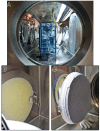ABSL-4 aerobiology biosafety and technology at the NIH/NIAID integrated research facility at Fort Detrick
- PMID: 24402304
- PMCID: PMC3917435
- DOI: 10.3390/v6010137
ABSL-4 aerobiology biosafety and technology at the NIH/NIAID integrated research facility at Fort Detrick
Abstract
The overall threat of a viral pathogen to human populations is largely determined by the modus operandi and velocity of the pathogen that is transmitted among humans. Microorganisms that can spread by aerosol are considered a more challenging enemy than those that require direct body-to-body contact for transmission, due to the potential for infection of numerous people rather than a single individual. Additionally, disease containment is much more difficult to achieve for aerosolized viral pathogens than for pathogens that spread solely via direct person-to-person contact. Thus, aerobiology has become an increasingly necessary component for studying viral pathogens that are naturally or intentionally transmitted by aerosol. The goal of studying aerosol viral pathogens is to improve public health preparedness and medical countermeasure development. Here, we provide a brief overview of the animal biosafety level 4 Aerobiology Core at the NIH/NIAID Integrated Research Facility at Fort Detrick, Maryland, USA.
Figures








References
-
- Alibek K., Handelman S. Biohazard: The Chilling True Story of the Largest Covert Biological Weapons Program in the World, Told from the Inside by the Man who Ran It. 1st ed. Random House; New York, NY, USA: 1999.
-
- Shurtleff A.C., Garza N., Lackemeyer M., Carrion R., Jr., Griffiths A., Patterson J., Edwin S.S., Bavari S. The impact of regulations, safety considerations and physical limitations on research progress at maximum biocontainment. Viruses. 2012;4:3932–3951. doi: 10.3390/v4123932. - DOI - PMC - PubMed
Publication types
MeSH terms
Substances
Grants and funding
LinkOut - more resources
Full Text Sources
Other Literature Sources
Medical

